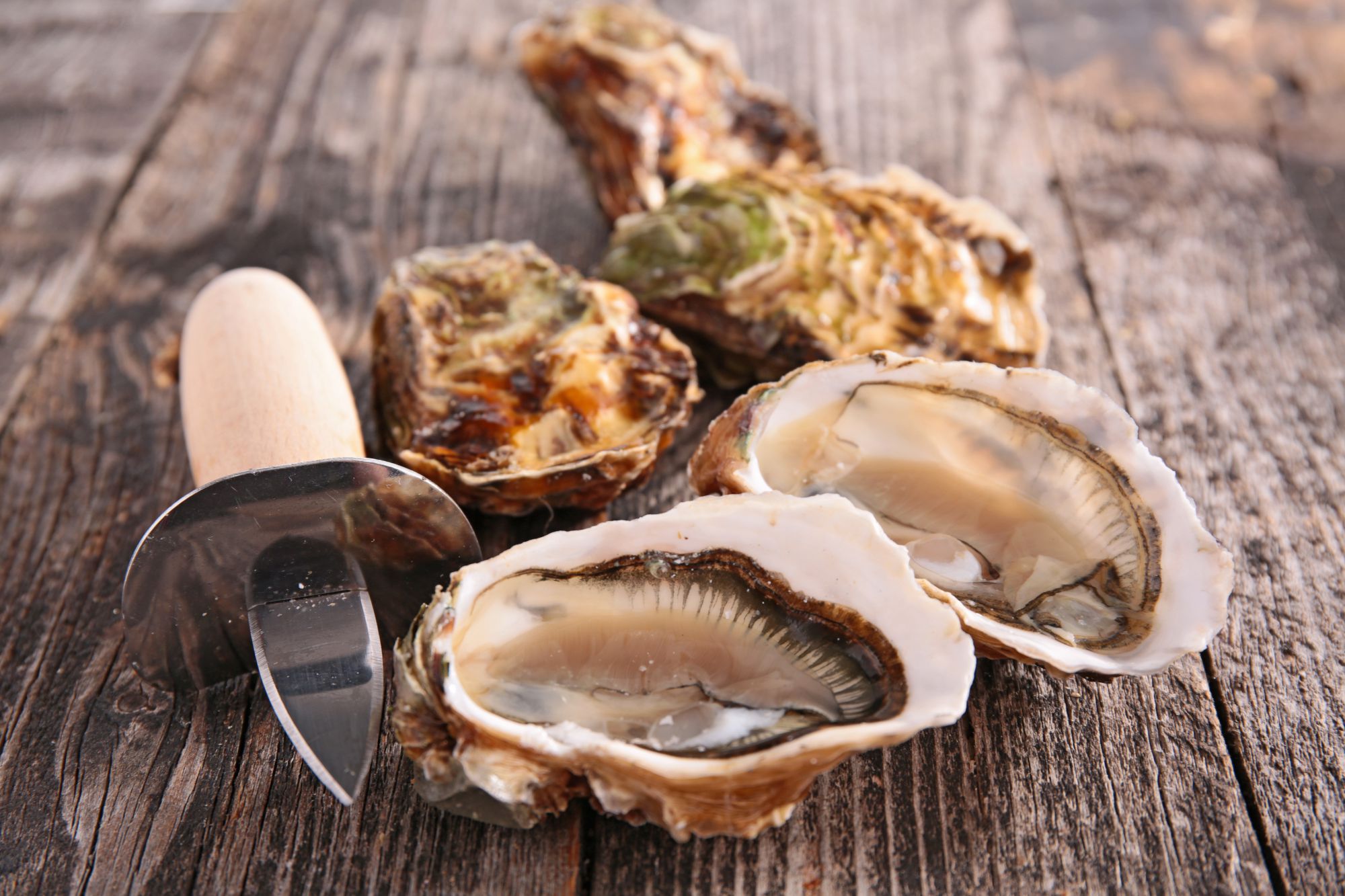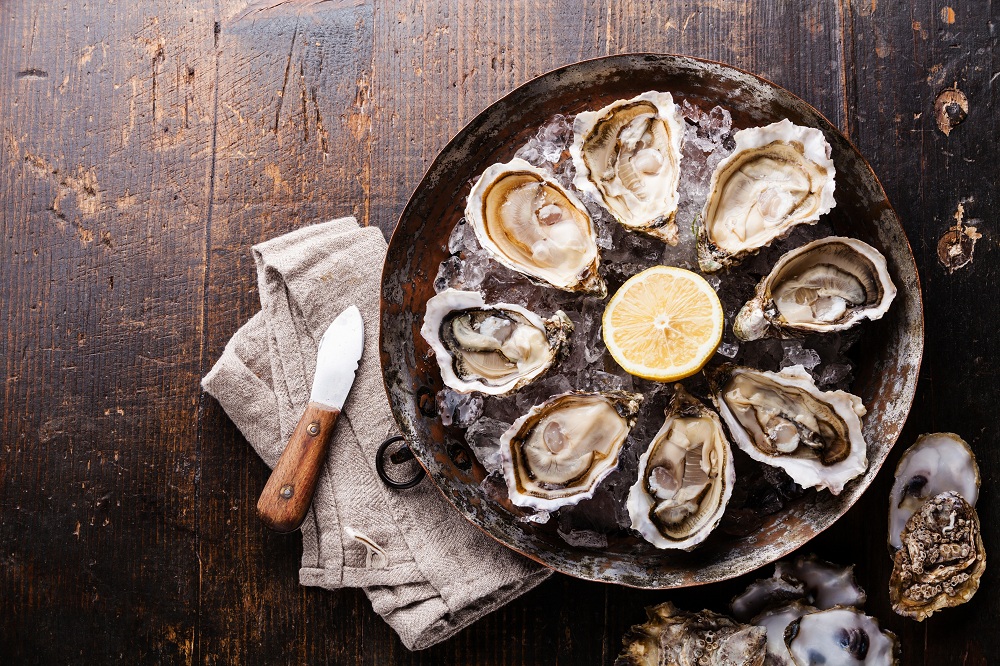Everything You Need to Know About OYSTERS!
Yesterday
we
posted
some
information
on
the
growing
demands,
as
well
as
the
growing
variety
in
oysters.
This
time,
we
wanted
to
share
with
you
everything
that
you
need
to
know
about
oysters.
From
health
facts
and
quality
checks
to
shucking
techniques
and
the
perfect
oyster
parings,
we
have
you
covered!
But
first,
lets
just
take
a
minute
to
remind
you
of
an
excellent
OYSTER
opportunity
ahead!
The Euclid Fish Market will be featuring our new EFC Raw Bar every Saturday from 11-2 through the month of February! We will have great deals on a variety of east coast oysters, all fresh shucked to order and all with a very unique flavor profile! We will also have shucking demos, product demos and featured recipes throughout the day. We hope to see you there! And for those that do attend, please be sure to share your photos at home or in the store with #EFCshellfie.
Now, back to the facts:
The Basics
Health
Facts-
“The
impressive
health
benefits
of
oysters
come
from
its
vast
stockpiles
of
minerals,
vitamins
and
organic
compounds.
In
fact,
certain
mineral
varieties
are
in
their
highest
content
in
oysters,
meaning
that
they
are
the
premiere
food
item
in
the
entire
world
for
supplementation,
particularly
of
zinc.
The
other
components
include
very
high
levels
of
protein,
vitamin
D,
vitamin
B12,
iron,
copper,
manganese,
and
selenium.
Oysters
also
contain
high
levels
of
niacin,
riboflavin,
thiamin,
vitamin
C,
phosphorus,
potassium,
and
sodium.
Finally,
oysters
are
a
huge
source
of
beneficial
cholesterol,
antioxidants,
omega-3
fatty
acids,
and
water.
These
elements
of
oysters
make
them
an
extremely
healthy
food
that
can
seriously
boost
your
body's
overall
function
and
health.”
Benefits:
- Boosts Immune System
- Beneficial for healing wounds
- Promotes blood circulation on body
- Helps to prevent Cardiovascular Disease
- Protects against osteoporosis and aids in increasing bone mineral density
- Aids in ensuring proper metabolic activity, tissue repair, cellular growth & muscle strength
For more information on the health benefits of Oysters, we suggest checking out Organic Facts.
Flavor
Profiles-
All
oysters
have
their
own
individual
flavor
profile
based
on
where
they
are
grown,
how
they
are
grown
and
its
climatic
factors.
However
one
thing
remains
consistent….
95%
of
the
oysters
we
eat
are
farmed
and
all
cultivated
in
a
highly
sustainable
way.
Our
oysters
in
house
are
all
Best
Choice
on
the
Seafood
Watch
Sustainability
Ratings.
For
an
awesome
guide
to
flavor
profiles,
we
suggest
checking
out
The
Oyster
Guide.
Types
There are many, many oysters throughout the world, however only very few species of oysters are harvested in the US for consumption. Atlantic / East Coast native (Crassostrea virginica), Pacific / West Coast non-native (Crassostrea gigas), European Native / Flat (Ostrea edulis), Olympia / West Coast native (Ostrea conchaphila) and Kumamoto (Crassostrea sikamea).
Great Things to Know When Ordering
East Coast vs. West Coast- what's the difference? Different water & species result in different tastes. It is important to keep in mind that each and every oyster is different. East Coast oysters tend to be higher in salinity and in brininess, light-bodied, crisp and buttery in flavor while West Coast oysters tend to range in salinity and brininess, more medium-bodied with mineral flavors that are creamy and sweet.
Because there are so many varieties and flavor profiles, we recommend focusing on 4-6 oysters at a time and ordering two of each kind. By ordering two, you are able to get a better sense of flavor and while limiting it to 4-6 varieties, you are not overwhelming your palate. We also understand that it is fun to order oysters from coast to coast, however we recommend ordering from one region at a time, especially when first trying them out!
Quality is Key
Believe us when we say, quality and freshness are one of the most important things when it comes to consuming raw oysters. It is important to know when your oysters were harvested. All shellfish will come with a tag, supplying you with the harvest date and location. Our 12 ct. bags in the store are all tagged with the information that we take and keep in a reporting system. Next, we suggest checking the oysters for their liquor. Your oysters should never look dried out as all fresh oysters are hydrated and filled with seawater.
(Side note- never rinse your oysters in tap water as this will ruin their delicious flavor.)
If you are unsure on how to shuck your oysters, we strongly suggest leaving it to someone who is experienced as it can be dangerous and can also ruin the oyster meat. When cleaning, all shell and grit will need to be removed as well as any bad or previously opened oysters that will need to be tossed.
Shucking
 As
previously
mentioned,
we
suggest
watching
and
learning
how
to
shuck
an
oyster
before
trying
at
home.
We
would
be
more
than
happy
to
show
you
how
to
do
it
here
in
the
store!
Once
you
get
an
idea
on
how
to
do
so,
please
follow
the
tips
below.
As
previously
mentioned,
we
suggest
watching
and
learning
how
to
shuck
an
oyster
before
trying
at
home.
We
would
be
more
than
happy
to
show
you
how
to
do
it
here
in
the
store!
Once
you
get
an
idea
on
how
to
do
so,
please
follow
the
tips
below.
First and foremost, it is extremely important that you use the right tool. We recommend that you use a good quality oyster knife and a pair of heavy gloves or a towel to protect your hand.
Make sure you are on a hard, flat surface with your oyster knife in your dominate hand, and your towel/ glove on your other that is holding the oyster. There is a flat side and a cupped side on the oyster; make sure that you hold the oyster with the cup side down and in your hand to hold the liquor. It is important that you start at the hinge with the knife blade pointed down while applying light pressure and working back and forth. Eventually, you should get an opened slit in the oyster. Once the knife is secured in the slit, twist and torque the knife back and forth until the shell pops open.
Make sure that you are always protecting the meat, not puncturing or losing the liquor. Once popped, you will need to cut the abductor muscle by sliding the blade across the top shell, then removing it. Finally, slide your knife under the bottom abductor to loosen the meat from the shell.
For a step by step process with pictures, we suggest using an instructional sheet provided by the Washington Department of Fish and Wildlife.
Tasting
Like drinking wine or sampling cheese, tasting oysters are very similar in the sense that you are exploring the different hint of flavors and textures, appreciating the way in which they were grown and where they came from.
For the optimal oyster experience, it all comes down to your senses... literally!
So what to do first? Well, you see it! Feast with your eyes. Compare the size, shape, coloring and body of the meat. Next, smell the oyster. Compare the brininess of the sea, the sweetness of the liquor and the different aromas from each oyster.
After smelling, we suggest sipping the liquor to get a feel for the flavor and a sense of salinity is best before slurping! And last but certainly not least, gently sway the meat of the oyster back and forth in the shell to loosen it up. Once loosened, move the oyster to your lips, tilt it back and slurp it down! For those of you who want the full flavor, chew it a few times before swallowing.
You should notice a whole array of flavors from salty to sweet and finishing with its abundant unique flavor.
Additional Flavors and Pairings
 Some
people
enjoy
their
oysters
raw
with
no
toppings
to
experience
the
raw
and
true
flavors
of
the
sea.
Although
we
suggest
trying
this
at
least
once,
we
know
that
some
people
may
struggle
with
it
at
first.
Adding
some
accoutrements
to
your
oyster
meat
can
add
a
great
element
of
flavor,
as
long
as
it
is
done
in
moderation.
Using
too
much
added
toppings
will
ruin
the
meat
of
the
oyster
and
the
flavors
of
nature's
bounty.
There
are
many
options
to
add,
some
of
which
are
listed
here.
For
the
lighter
flavors,
we
suggest
using
just
a
squirt
of
a
lemon,
a
pinch
of
fresh
ground
black
pepper
or
a
red
wine
vinaigrette
and
shallot
mignonette.
For
those
that
want
a
little
more
of
a
kick;
horseradish,
Tabasco
hot
sauce
or
cocktail
sauce
are
great
as
well.
Some
people
enjoy
their
oysters
raw
with
no
toppings
to
experience
the
raw
and
true
flavors
of
the
sea.
Although
we
suggest
trying
this
at
least
once,
we
know
that
some
people
may
struggle
with
it
at
first.
Adding
some
accoutrements
to
your
oyster
meat
can
add
a
great
element
of
flavor,
as
long
as
it
is
done
in
moderation.
Using
too
much
added
toppings
will
ruin
the
meat
of
the
oyster
and
the
flavors
of
nature's
bounty.
There
are
many
options
to
add,
some
of
which
are
listed
here.
For
the
lighter
flavors,
we
suggest
using
just
a
squirt
of
a
lemon,
a
pinch
of
fresh
ground
black
pepper
or
a
red
wine
vinaigrette
and
shallot
mignonette.
For
those
that
want
a
little
more
of
a
kick;
horseradish,
Tabasco
hot
sauce
or
cocktail
sauce
are
great
as
well.
When pairing oysters with wines, beers and liquors… it really is pretty simple. Oysters go with just about anything so pair it with something that you truly enjoy! As a general rule for wines, try to match the acidity of the wine to the brininess of the oyster. Usually the best pairings are with crisp, dry white wines. When pairing oysters with beer…. Well let's just say any beer is a PERFECT pair. From light lagers to dark stouts and IPA's, you really can't go wrong!
Although any liquor drinks are great, most suggest that clean, palate cleansers are the best. Martini's and whiskey fall under this category. If those are not your style, no worries. Drinks with bitters tend to pair very well as the balance of a bitter and the salt from an oyster are great. Also, any citrus flavors pair well with seafood so stick with something light to pair with the flavor of the sea. A lot of west coasts oysters tend to have a cucumber like finish, so how about a gin and tonic with cucumbers? Really, anything you choose is the best way to take advantage of a sea to land experience if desired.
For additional information, please feel free to stop in the market or call us at 440.951.6448!
Happy Slupring!
The Euclid Fish Company
